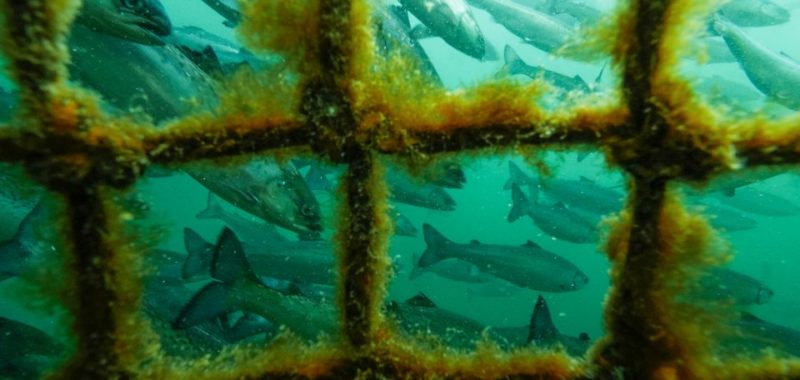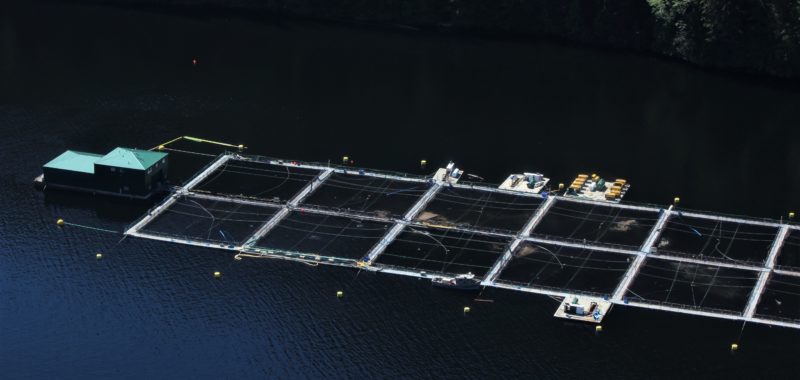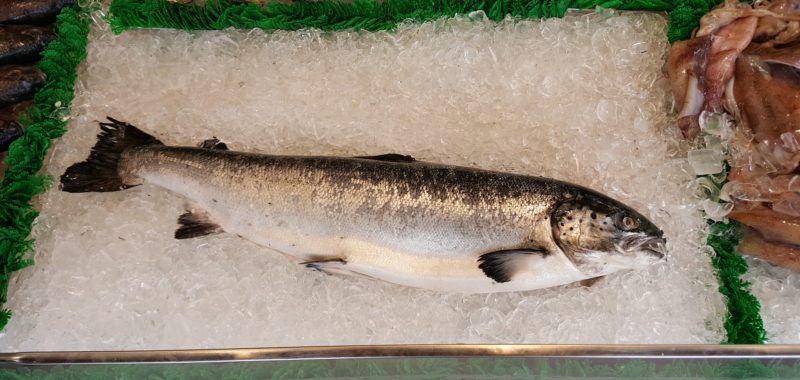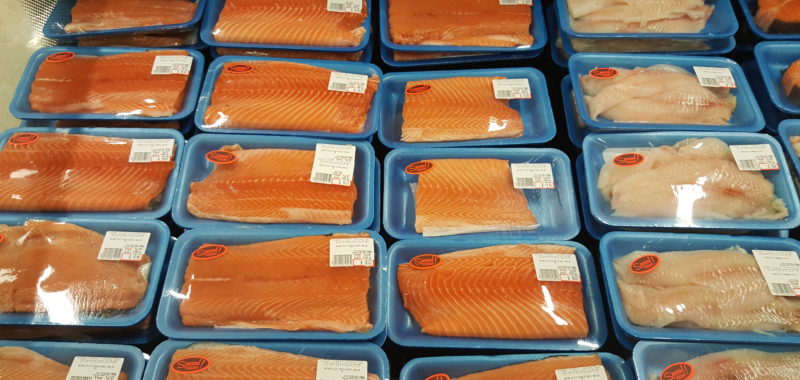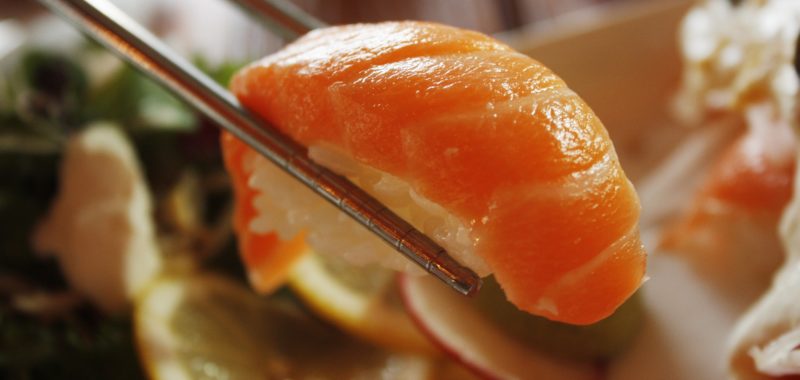Priority Species: Atlantic Salmon (farmed British Columbia)
Scientific name: Salmo salar
Click on the link to view the rankings/certifications for this species:
Seafood Watch
Ocean Wise
ASC
Open-net pen salmon farms situated along fish migration routes can pose a potential threat to wild salmon populations. Thirteen Pacific wild salmon populations are currently listed by COSEWIC as either Endangered or Threatened, while another five are listed as ‘Special Concern’ (dive deeper into the status of wild Pacific salmon). The majority of these are Fraser River sockeye populations – which were recently assessed by the Committee on the Status of Endangered Wildlife in Canada (COSEWIC). A recommendation to add endangered Fraser River sockeye to Canada’s Species at Risk Act (SARA) has been made.
Open-net pen salmon farms can be potential breeding grounds for sea lice and disease pathogens. If wild salmon swim past these farms there is a higher risk of them becoming infected, which is why farm location really matters. Lethal impacts of sea lice on wild salmon populations are well documented, and the increased vulnerability of wild salmon populations near farms with ineffective sea lice management strategies, and so higher lice loads, remains a serious concern.
Of particular concern in B.C. are piscine reovirus (PRV) and heart and skeletal muscle inflammation (HSMI). A Strategic Salmon Health Initiative (SSHI) paper confirmed that HSMI occurs in the B.C. farmed salmon industry. HSMI has been confirmed to be caused by PRV, and PRV has been found in B.C. wild salmon. Another SSHI paper suggests that the PRV strain found in B.C. causes jaundice/anemia in Chinook salmon and concluded that wild “migratory chinook salmon may be at more than a minimal risk of disease from exposure to the high levels of PRV occurring in salmon farms”. Many South Coast Chinook populations were recently listed as endangered or threatened. West Coast Vancouver Island populations are considered in the ‘red’ zone.
Antibiotics use in the industry is considered high and parasiticides (i.e. pesticides) are used to combat sea lice. Such chemicals inevitably enter the marine ecosystem.
Farmed salmon escapees can compete with wild Pacific salmon for food and spawning habitat. Feral and breeding farmed salmon have been previously documented in rivers in B.C. While industry self-reporting suggests large-scale escapes have declined in recent years, the vulnerability of net pens to large and trickle escapes remains.
Other concerns include marine mammal deaths, incidental catch of wild fish, habitat damage and pollution, as well as the reliance on wild fish stocks for fish feed. In addition, a number of farms are located in unceded First Nations territories that actively oppose open-net salmon farming.
The only way to eliminate the unnecessary risks to wild fish populations is by farming with land-based closed containment systems. Given the ‘closed’ nature of the system, the risk of infection by disease and sea lice are greatly reduced or eliminated. Pesticides are not used, and antibiotic use is typically much lower. Most importantly, land-based closed farms ensure farmed and wild fish are physically separated.
In the meantime, the salmon farming industry can apply the precautionary principle and take a science-driven approach to managing the impacts of open-net pen salmon farms on the marine environment. Other incremental improvements include:
Escapes: At a minimum, open-net pen systems should be regulated to set construction and facilities standards, prevention and response plans, and ongoing monitoring and enforcement. Government authorities should implement rigorous, robust and continuous monitoring in wild salmon ecosystems at risk from farmed salmon escapees.
Disease, Parasites and Chemicals: Locating farm sites away from wild salmon migration routes would help to minimize potential disease and parasite transfer. Further disease science and understanding is hindered by the lack of public access to farmed fish health data. A priority for the Canadian (federal and provincial) governments and aquaculture industry should be the timely disclosure and transparency of fish health event reporting.
The adoption and implementation of area or ecosystem-based management is necessary for successful disease/sea lice outbreak prevention and mitigation. Incorporating non-chemical preventative tools, such as effective fallowing periods 2 and cleaner fish (a natural predator of sea lice), could help reduce dependency on pesticides.
Markets: SeaChoice will continue to promote better labelling on salmon products sold in the Canadian market, to make it easier for consumers to identify between wild (Pacific) and farmed salmon. We also encourage consumers, retailers and restaurants to source sustainably-caught wild Pacific salmon or farmed closed containment salmon, trout or char instead.
Aquaculture section of SeaChoice website
Related SeaChoice ASC submissions can be found here
Aquaculture Stewardship Council certified salmon isn’t a “Good Alternative” – SeaChoice media release, June 5, 2017
SeaChoice rejects ranking of B.C. farmed salmon as “Good Alternative” – SeaChoice media release, September 18, 2017
Living Oceans Society – Salmon Farming
Strategic Salmon Health Initiative
Environmental management reports for aquaculture in British Columbia – DFO
Common/Market Name
Salmon, Atlantic Salmon
Distribution
Farmed in coastal waters around Vancouver Island, south coast Mainland BC
Harvest Method
Aquaculture methods: Open-net pen, closed containment
Management Agency
Department of Fisheries and Oceans Canada (DFO) for licences, BC Forests, Lands, Natural Resource Operations & Rural Development (FLNRO) for tenures
Market Distribution
U.S. (63.5 per cent), Canada (28.5 per cent), Asia (China, Korea, 6 per cent) Other (2 per cent) (data from Statistics Canada and BCSFA)
